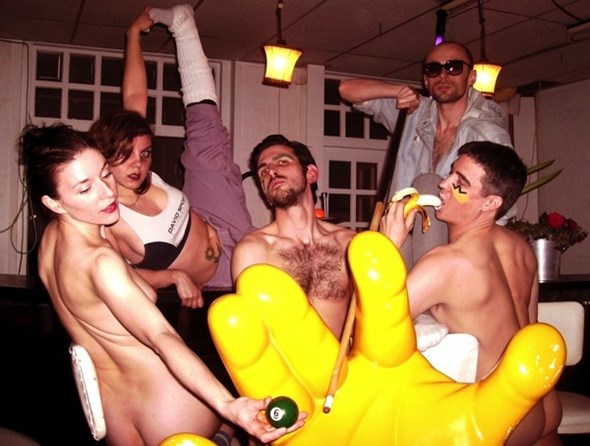
Poster for D.I.E. NOW, 2010 Onestar Press
The Aroma of Opinions
Best known by her videos and novels that deal with the ease that modern relationships succumb to manipulation KEREN CYTTER appears to have changed horses midstream. Two years ago she founded the theatrical dance company D.I.E. NOW (Dance International Europe Now), and presented their latest piece The True Story of John Webber and his Endless Struggle with the Table of Content prominently on an international scale. ANDREAS SCHLAEGEL met the artist.
Keren Cytter: Did you like the poster for D.I.E. NOW? I posted it on facebook. I don’t remember you liking it. Here …
Andreas Schlaegel: Where are you? Oh, you’re the hand!
I think Luc said, let’s get undressed, and when everybody was undressed he ended up having his clothes on again. Fabian was really shy. It took some time.
You once told me, they’re all not dancers. Fabian is an actor?
Fabian is an actor, Susie is an actress, Dafna is a video artist, Andrew is a video and performance artist, Luc is a mime. He studied it at the only school there is for it, in Holland. You learn to control separate parts of your body.
Let’s start with practical stuff. How do you work and organize your video shoots? Do you have a structure, a little machine that produces the work for you?
Yes and no. I organize the whole thing myself. Usually I have about five people working on a video, Dafna acting as producer, me, and the actors. I film everything myself. Look at my hands. Don’t they look like a working-woman’s hands? I once had a visitor ask me for a tip on making documentary videos and I told her: Don’t drink coffee before the shoot, or your hands will shake too much. That’s the recommendation I can give. I also do the editing myself.
You often seem to work with the same people, and the dynamics that this small group produces. Have you ever thought of increasing the scale of your production?
I did one large scale production so far. It was much more fun for me, because I could let others do a lot of the work. But then again, much of the work was more in the beginning, raising money and so on.
But the theatre is actually on a bigger scale, isn’t it? You need to work with technicians, lights and so on?
Yes, but I knew exactly how I wanted the light to be. Of course I had more ideas while we were working on it. The light designer came in the beginning, once in the middle and again towards the end, and then we decided on a bit more than 150 light cues. That’s a lot, she said. And the sound is from the DVD, which is operated by the actors behind the stage. I don’t have to talk to another person and this way, we really get to finish the work during the rehearsals.
Did you look at theatre in Berlin for inspiration?
I didn’t go to the theatre at all in the last five or six years.
Not at all?
No. I did see Michael Clark, the dancer, in London recently, after we performed at the Tate. But I have good taste. I know how to flirt with the audience.
Andreas Schlaegel: Where are you? Oh, you’re the hand!
I think Luc said, let’s get undressed, and when everybody was undressed he ended up having his clothes on again. Fabian was really shy. It took some time.
You once told me, they’re all not dancers. Fabian is an actor?
Fabian is an actor, Susie is an actress, Dafna is a video artist, Andrew is a video and performance artist, Luc is a mime. He studied it at the only school there is for it, in Holland. You learn to control separate parts of your body.
Let’s start with practical stuff. How do you work and organize your video shoots? Do you have a structure, a little machine that produces the work for you?
Yes and no. I organize the whole thing myself. Usually I have about five people working on a video, Dafna acting as producer, me, and the actors. I film everything myself. Look at my hands. Don’t they look like a working-woman’s hands? I once had a visitor ask me for a tip on making documentary videos and I told her: Don’t drink coffee before the shoot, or your hands will shake too much. That’s the recommendation I can give. I also do the editing myself.
You often seem to work with the same people, and the dynamics that this small group produces. Have you ever thought of increasing the scale of your production?
I did one large scale production so far. It was much more fun for me, because I could let others do a lot of the work. But then again, much of the work was more in the beginning, raising money and so on.
But the theatre is actually on a bigger scale, isn’t it? You need to work with technicians, lights and so on?
Yes, but I knew exactly how I wanted the light to be. Of course I had more ideas while we were working on it. The light designer came in the beginning, once in the middle and again towards the end, and then we decided on a bit more than 150 light cues. That’s a lot, she said. And the sound is from the DVD, which is operated by the actors behind the stage. I don’t have to talk to another person and this way, we really get to finish the work during the rehearsals.
Did you look at theatre in Berlin for inspiration?
I didn’t go to the theatre at all in the last five or six years.
Not at all?
No. I did see Michael Clark, the dancer, in London recently, after we performed at the Tate. But I have good taste. I know how to flirt with the audience.
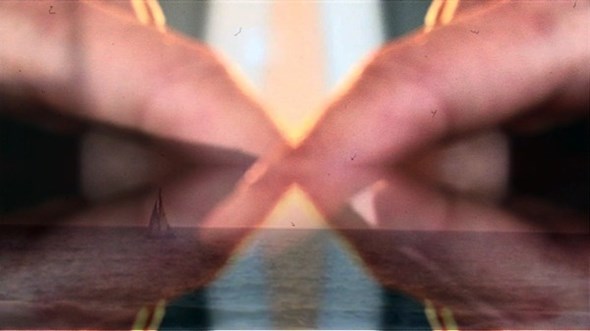
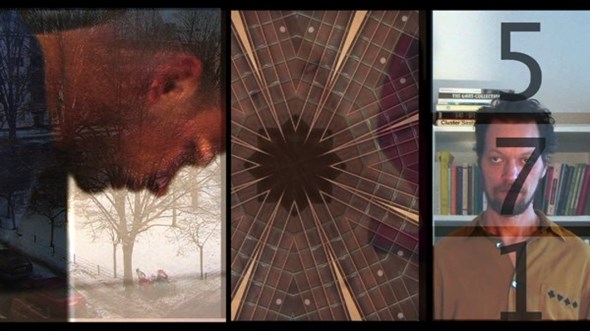
The coat, 2010
Didn’t you conceive D.I.E. NOW in 2008 as a two-year program? Is it going to be over now?
No, now we are a foundation. It was originally conceived as part of the curatorial platform If I can’t dance, I don’t want to be part of your revolution at the end of 2008, but we became bigger and bigger until we became our own show. And people want us. So I decided, with the producers, to turn it into a foundation, and we will have a new show in 2011. We practice.
But did something change within the group since you turned it into a foundation?
Not much. I just don’t know if you are allowed to have a foundation that is called D.I.E. NOW.
Maybe, because when someone dies, their body rots and turns into the foundation for something new?
Yes! So die now! It just makes it easier to deal with money.
But will there be a new piece?
When we started in 2008 we did a small piece at De Appel, and then more small pieces at the Café, and Bilbao, which we also did at Hebbel am Ufer in Berlin, the one with the mirror.
What is your relationship with Dan Graham and this particular piece, Performer/Audience/Mirror (1977)?
The deadline. I had two days to write it and no time to invent new stuff. I found this piece in the Internet and decided to stick to it. In Dublin it was the first time we did something onstage, and it was half an hour. And then we did this one, the Table of Content. So we have lots of small performances.
So how did you assemble the group?
Luc and Dafna came when I assembled the first show. We enjoyed working together so we called it a dance company. Susie was in my movies, so I asked her to join, and Andrew is a friend of mine, we studied together, so I asked him, too. He came in for the second performance at the Café. And Fabian came for the big one.
Is the new piece going to continue the story from the Table of Content?
No, I’m thinking of a new style, maybe more realistic. We practised for one month for the last piece, for the new one we will probably practice two months. We cannot only rely on our charm ….
Not anymore?
I refuse to believe I’m not charming! No, I want to do something new. When we started I didn’t know anything about dance, but now I understand a little bit more. I understand that acting is much more important on stage than it is in film, and that it’s not so easy to make a flashback on stage. On stage, time passes more quickly than in film, so fast dialogues become extremely annoying on stage, which means I should rely on my new understanding. It’s a combination of four dances. I have a DVD of William Forsythe that I’m planning to watch to increase my knowledge. I’m planning on becoming a dance expert. I’m giving a talk on dance in Glasgow!
You mentioned a lot of influences in the synopsis for the Table of Content, such as Pina Bausch, Yvonne Rainer, and …
Don’t forget Thai shadow theatre. And it is true, Yvonne Rainer uses repetitive movements, like we do, Pina Bausch uses a theatrical form of dance, we do Michael Jackson’s Moonwalk, Lambada, we have everything in it. We even did »River Dance«, to spice up the third of the four shows in Berlin. The night before the show, we decided that Dafna should do the »River Dance« when Fabian describes triangles with his hands. After one hour of practicing she showed me something. I told her, that’s not »River Dance«! She said, I’m doing my best, okay? During the performance I was asked: What is she doing? I told her, ha, you see, it’s new! It was very quick. Oh, and a girl told Dafna that she liked that part the most, because that was the moment the show became »completely abstract«. That was nice. We didn’t do it again. But I’m humble. I didn’t mention »River Dance« as a source of inspiration.
No, now we are a foundation. It was originally conceived as part of the curatorial platform If I can’t dance, I don’t want to be part of your revolution at the end of 2008, but we became bigger and bigger until we became our own show. And people want us. So I decided, with the producers, to turn it into a foundation, and we will have a new show in 2011. We practice.
But did something change within the group since you turned it into a foundation?
Not much. I just don’t know if you are allowed to have a foundation that is called D.I.E. NOW.
Maybe, because when someone dies, their body rots and turns into the foundation for something new?
Yes! So die now! It just makes it easier to deal with money.
But will there be a new piece?
When we started in 2008 we did a small piece at De Appel, and then more small pieces at the Café, and Bilbao, which we also did at Hebbel am Ufer in Berlin, the one with the mirror.
What is your relationship with Dan Graham and this particular piece, Performer/Audience/Mirror (1977)?
The deadline. I had two days to write it and no time to invent new stuff. I found this piece in the Internet and decided to stick to it. In Dublin it was the first time we did something onstage, and it was half an hour. And then we did this one, the Table of Content. So we have lots of small performances.
So how did you assemble the group?
Luc and Dafna came when I assembled the first show. We enjoyed working together so we called it a dance company. Susie was in my movies, so I asked her to join, and Andrew is a friend of mine, we studied together, so I asked him, too. He came in for the second performance at the Café. And Fabian came for the big one.
Is the new piece going to continue the story from the Table of Content?
No, I’m thinking of a new style, maybe more realistic. We practised for one month for the last piece, for the new one we will probably practice two months. We cannot only rely on our charm ….
Not anymore?
I refuse to believe I’m not charming! No, I want to do something new. When we started I didn’t know anything about dance, but now I understand a little bit more. I understand that acting is much more important on stage than it is in film, and that it’s not so easy to make a flashback on stage. On stage, time passes more quickly than in film, so fast dialogues become extremely annoying on stage, which means I should rely on my new understanding. It’s a combination of four dances. I have a DVD of William Forsythe that I’m planning to watch to increase my knowledge. I’m planning on becoming a dance expert. I’m giving a talk on dance in Glasgow!
You mentioned a lot of influences in the synopsis for the Table of Content, such as Pina Bausch, Yvonne Rainer, and …
Don’t forget Thai shadow theatre. And it is true, Yvonne Rainer uses repetitive movements, like we do, Pina Bausch uses a theatrical form of dance, we do Michael Jackson’s Moonwalk, Lambada, we have everything in it. We even did »River Dance«, to spice up the third of the four shows in Berlin. The night before the show, we decided that Dafna should do the »River Dance« when Fabian describes triangles with his hands. After one hour of practicing she showed me something. I told her, that’s not »River Dance«! She said, I’m doing my best, okay? During the performance I was asked: What is she doing? I told her, ha, you see, it’s new! It was very quick. Oh, and a girl told Dafna that she liked that part the most, because that was the moment the show became »completely abstract«. That was nice. We didn’t do it again. But I’m humble. I didn’t mention »River Dance« as a source of inspiration.
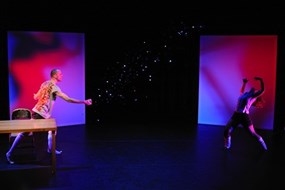
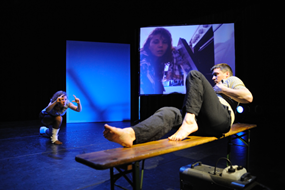
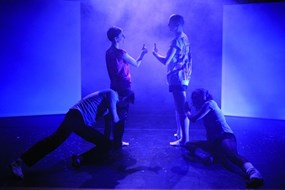
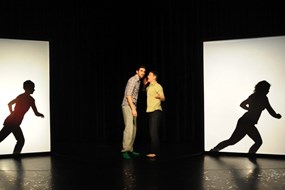
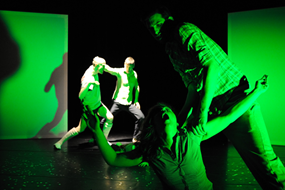
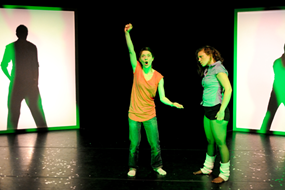
The True Story of John Webber and his Endless Struggle with the Table of Content, Plaza Futura Theater, Einhoven 2010
The John Webber character – is he based on someone in particular? You called him a liberal activist. He wants to liberate people?
I thought he is someone who sits and demonstrates against Neo-Nazis. It is also my criticism of liberal people. I am more right-wing, actually. I think most liberal activists are extremely non-liberal. The waitress falls in love with him for the »aroma of his opinions«. Very sexy. Yeah, that’s why people fall for such people. Except me. I fall for fascists. Like Silvia Plath said, »Every woman adores a Fascist«.
In your piece the characters fall in love and then the whole world changes gender …
I started having this idea for a movie, with the sex change. I wanted it to start realistically, like a Dogma film. A guy wakes up, looks in a mirror and you don’t know what’s going on. He goes into the living room, starts touching himself, masturbates. Time passes, maybe half an hour later, he picks up the phone, and only when he starts talking does he realize that he used to be a woman but woke up as a man, and then the plot starts. That was my idea.
But then I decided to use the idea for the theatre, but didn’t know how to continue. We started to do little performances, and when Andrew joined, he said, he wanted to die in the big piece, and I knew he was going to be John Webber. So then it was easy, if you know you have to kill someone and you know who it is …. Slowly I found out why. I knew after a while that the entire world was going to have this sex change, just to make things more reasonable, because if it were only John Webber it would have been bizarre. But when I knew he was going to die, slowly the plot came together. Someone would blame him, and the men who had become women would want their power back.
I thought he is someone who sits and demonstrates against Neo-Nazis. It is also my criticism of liberal people. I am more right-wing, actually. I think most liberal activists are extremely non-liberal. The waitress falls in love with him for the »aroma of his opinions«. Very sexy. Yeah, that’s why people fall for such people. Except me. I fall for fascists. Like Silvia Plath said, »Every woman adores a Fascist«.
In your piece the characters fall in love and then the whole world changes gender …
I started having this idea for a movie, with the sex change. I wanted it to start realistically, like a Dogma film. A guy wakes up, looks in a mirror and you don’t know what’s going on. He goes into the living room, starts touching himself, masturbates. Time passes, maybe half an hour later, he picks up the phone, and only when he starts talking does he realize that he used to be a woman but woke up as a man, and then the plot starts. That was my idea.
But then I decided to use the idea for the theatre, but didn’t know how to continue. We started to do little performances, and when Andrew joined, he said, he wanted to die in the big piece, and I knew he was going to be John Webber. So then it was easy, if you know you have to kill someone and you know who it is …. Slowly I found out why. I knew after a while that the entire world was going to have this sex change, just to make things more reasonable, because if it were only John Webber it would have been bizarre. But when I knew he was going to die, slowly the plot came together. Someone would blame him, and the men who had become women would want their power back.

Four Seasons, 2009
You also inserted bits of film, of the experiment at the mental hospital, where completely sane people were diagnosed as insane.
It’s from The Trap, a documentary by Adam Curtis. I had just seen it and decided to put it in, because I decided it would fit.
It gives you the impression that maybe this is a fantasy.
As if they were all going crazy. I knew you would make this connection.
And the other part – about the Yanomamo people in Venezuela?
I took everything from The Trap. It’s a fascinating series. It consists of three parts, but only the first two parts are good. Then it turns to more banal politics. There is the guy with the beard, Alan Watts. He is a philosopher. I found his name mentioned in connection with Derrida, as a popular, but not really reliable, philosopher. Then I was looking for something other than The Trap to put in, and he was the first hit ongoogle. I thought: I can mash up his lectures. He looks like a guru, but when he speaks, you get the impression he doesn’t know what he is talking about or is making it up on the fly. I checked the responses to him on Youtube, and he was being flattered for all the wrong reasons: yeah he’s so great, finally someone is speaking a normal language, and giving nice explanations and metaphors.
But from the beginning: you wrote the script and took it to the actors?
And I prepared the music. I composed it on Garageband; it’s not exactly brain surgery. It was actually much funnier when we read it for the first time. Maybe we weren’t so used to the jokes yet. Also the dancers didn’t really understand it yet. They had to find things to do.
In what sense?
For example, at one point I wrote that they are doing a love dance, and then they had to invent it with the music. This took some time. We had some tense moments, because sometimes they would like things that I didn’t. I was listening to them, which I realized I shouldn’t do, because they don’t see themselves. Then I told them they have no rights anymore, we did the changes and that was that.
As for the stage, you designed it and decided to have the three screens and the shadows?
Yeah. I realised we didn’t have the budget to allow us to show all of society change gender, so I thought the element of shadow play would be a nice way to visualize it. Also it’s entertaining, when you don’t have as many actors. It worked out really nicely. I didn’t know that shadows could be so sharp.
I liked the repetition in the beginning. Andrew is very precise in his movements and his pronunciation.
It was an improvisation. In fact it is an imitation of a real fuck up. He pissed me off, because he didn’t even say sorry.
It also helps the audience to actively listen to what he’s saying. To try and detect the fuck-up, but also to understand what the piece is about.
No essential information is mentioned twice. Only non-essential information is repeated, like: Why did you kill him? Because I loved him. And that’s it. But maybe you should ask me about crossover?
Crossover?
A lot of artists deal with different disciplines and do crossover these days, but I’m not so interested in it. I don’t see myself as an artist – when I’m doing theatre, I see myself as a theatre person. Only, I’m lucky, because the idea of crossover already exists, so people can forgive me and see what I’m doing as crossover, and not as pretending.
How about novels, have you been writing any books?
Yes, my latest one is called The Amazing True Story of Moshe Klinberg – A Media Star, just published by Onestar press, who are also doing the edition with the poster. And my diary is coming out in Japan in May.
But you remain in the world of fiction anyway, yes?
Yeah, but a bit of reality, too.
But inside the fiction, and outside of you.
I’m not there. Never use your head.
It’s from The Trap, a documentary by Adam Curtis. I had just seen it and decided to put it in, because I decided it would fit.
It gives you the impression that maybe this is a fantasy.
As if they were all going crazy. I knew you would make this connection.
And the other part – about the Yanomamo people in Venezuela?
I took everything from The Trap. It’s a fascinating series. It consists of three parts, but only the first two parts are good. Then it turns to more banal politics. There is the guy with the beard, Alan Watts. He is a philosopher. I found his name mentioned in connection with Derrida, as a popular, but not really reliable, philosopher. Then I was looking for something other than The Trap to put in, and he was the first hit ongoogle. I thought: I can mash up his lectures. He looks like a guru, but when he speaks, you get the impression he doesn’t know what he is talking about or is making it up on the fly. I checked the responses to him on Youtube, and he was being flattered for all the wrong reasons: yeah he’s so great, finally someone is speaking a normal language, and giving nice explanations and metaphors.
But from the beginning: you wrote the script and took it to the actors?
And I prepared the music. I composed it on Garageband; it’s not exactly brain surgery. It was actually much funnier when we read it for the first time. Maybe we weren’t so used to the jokes yet. Also the dancers didn’t really understand it yet. They had to find things to do.
In what sense?
For example, at one point I wrote that they are doing a love dance, and then they had to invent it with the music. This took some time. We had some tense moments, because sometimes they would like things that I didn’t. I was listening to them, which I realized I shouldn’t do, because they don’t see themselves. Then I told them they have no rights anymore, we did the changes and that was that.
As for the stage, you designed it and decided to have the three screens and the shadows?
Yeah. I realised we didn’t have the budget to allow us to show all of society change gender, so I thought the element of shadow play would be a nice way to visualize it. Also it’s entertaining, when you don’t have as many actors. It worked out really nicely. I didn’t know that shadows could be so sharp.
I liked the repetition in the beginning. Andrew is very precise in his movements and his pronunciation.
It was an improvisation. In fact it is an imitation of a real fuck up. He pissed me off, because he didn’t even say sorry.
It also helps the audience to actively listen to what he’s saying. To try and detect the fuck-up, but also to understand what the piece is about.
No essential information is mentioned twice. Only non-essential information is repeated, like: Why did you kill him? Because I loved him. And that’s it. But maybe you should ask me about crossover?
Crossover?
A lot of artists deal with different disciplines and do crossover these days, but I’m not so interested in it. I don’t see myself as an artist – when I’m doing theatre, I see myself as a theatre person. Only, I’m lucky, because the idea of crossover already exists, so people can forgive me and see what I’m doing as crossover, and not as pretending.
How about novels, have you been writing any books?
Yes, my latest one is called The Amazing True Story of Moshe Klinberg – A Media Star, just published by Onestar press, who are also doing the edition with the poster. And my diary is coming out in Japan in May.
But you remain in the world of fiction anyway, yes?
Yeah, but a bit of reality, too.
But inside the fiction, and outside of you.
I’m not there. Never use your head.

Four Seasons, 2009
ANDREAS SCHLAEGEL is a writer and a member of the Art Critics Orchestra. He lives in Berlin.
KEREN CYTTER, born in 1977 in Tel Aviv. Lives in Berlin. Recent solo exhibitions include a.o. Moderna Museet, Stockholm; Repulsion, Kunsthaus Baselland; Galerie Christian Nagel, Berlin; Hammer Museum Project Series, Los Angeles; Morality Keren Cytter: Cross.Flowers.Rolex, Schau Ort, Zurich (2010); Noga Gallery of Contemporary Art, Tel Aviv; History in the Making (mit D.I.E Now), Tate Modern Turbine Hall, London; Performa 09, New York; CCA Center for Contemporary Art, Kitakyushu, Japan; Domestics, Pilar Corrias Gallery, London (2009); Witte de With, Rotterdam; The Victim, MUMOK, Vienna; Dreamtalk, Thierry Goldberg Projects, New York (2008). Exhibition participations include a.o. Gwangju Biennial; Not Necessarily In That Order, Presentation House Gallery, Vancouver; Morality, Witte de With, Rotterdam (2010); Return to Baroque, Museo Madre, Naples; Venice Biennial; National galerie Prize for Young Art, Hamburger Bahnhof, Berlin; The Generational: Younger Than Jesus, New Museum, New York (2009); Television Delivers People, Whitney Museum, New York; Manifesta 7, Trentino; Konzepte der Liebe, Kölnischer Kunstverein.
Represented by Galerie Christian Nagel, Cologne, Berlin; Pilar Corrias, London; Schau Ort, Zurich
KEREN CYTTER, born in 1977 in Tel Aviv. Lives in Berlin. Recent solo exhibitions include a.o. Moderna Museet, Stockholm; Repulsion, Kunsthaus Baselland; Galerie Christian Nagel, Berlin; Hammer Museum Project Series, Los Angeles; Morality Keren Cytter: Cross.Flowers.Rolex, Schau Ort, Zurich (2010); Noga Gallery of Contemporary Art, Tel Aviv; History in the Making (mit D.I.E Now), Tate Modern Turbine Hall, London; Performa 09, New York; CCA Center for Contemporary Art, Kitakyushu, Japan; Domestics, Pilar Corrias Gallery, London (2009); Witte de With, Rotterdam; The Victim, MUMOK, Vienna; Dreamtalk, Thierry Goldberg Projects, New York (2008). Exhibition participations include a.o. Gwangju Biennial; Not Necessarily In That Order, Presentation House Gallery, Vancouver; Morality, Witte de With, Rotterdam (2010); Return to Baroque, Museo Madre, Naples; Venice Biennial; National galerie Prize for Young Art, Hamburger Bahnhof, Berlin; The Generational: Younger Than Jesus, New Museum, New York (2009); Television Delivers People, Whitney Museum, New York; Manifesta 7, Trentino; Konzepte der Liebe, Kölnischer Kunstverein.
Represented by Galerie Christian Nagel, Cologne, Berlin; Pilar Corrias, London; Schau Ort, Zurich
